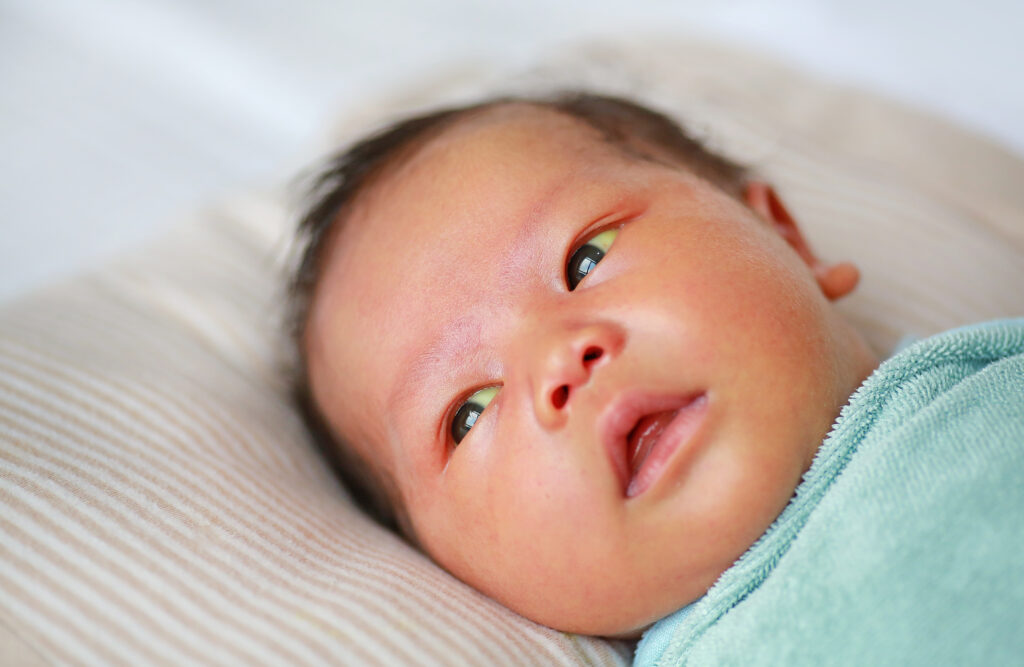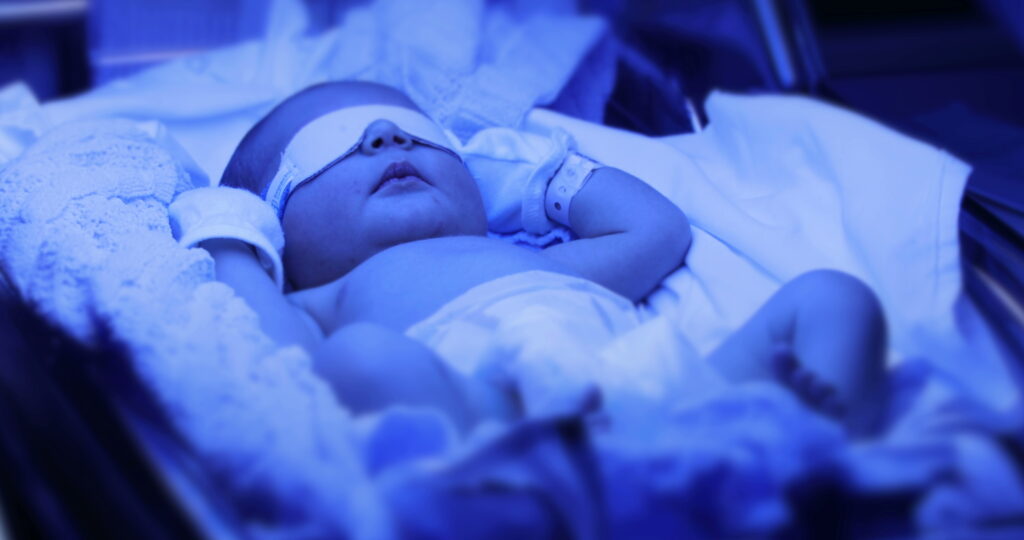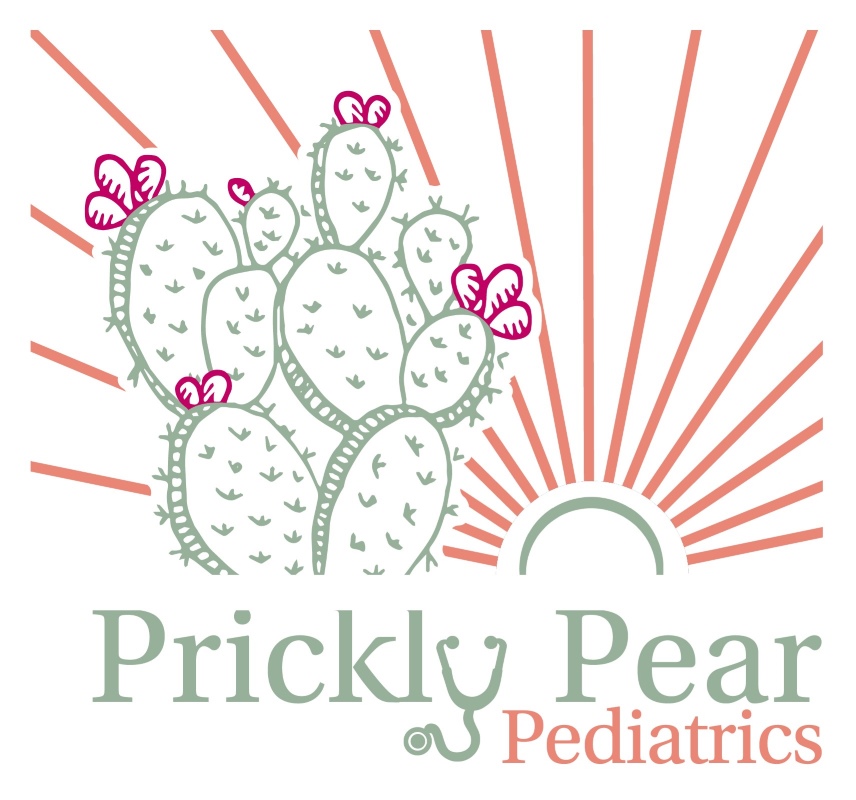Newborn Jaundice

Have you ever seen a newborn baby whose looked yellow, almost like a highlighter or a pumpkin? You may have even noticed that the white parts of the baby’s eyes appeared yellow colored. Your eyes were not playing tricks on you. This is called jaundice, and it is a very common occurrence in the newborn period. Here I will review why otherwise healthy babies develop jaundice in the newborn period, how we treat jaundice, and what families should know if their baby has jaundice.
What is newborn jaundice?
Jaundice is a term that describes the yellow discoloration of the baby’s skin and eyes caused by an increase in a bilirubin in the blood. Bilirubin is a yellow/brown colored molecule that is produced by the breakdown of red blood cells. The bilirubin molecule gets deposited in the subcutaneous tissues and skin, which causes the yellow color. Pretty much all newborns have some degree of jaundice due to the factors listed below.
Why do newborn babies get jaundice?
- Newborns have more red blood cells, and the lifespan of their blood cells is shorter than ours. This means that newborn babies are breaking down and recycling more red blood cells compared to everyone else. More red blood cell breakdown = more bilirubin production.
- Newborns have immature livers. The liver is the organ in the body that helps get rid of bilirubin. For the first 2 weeks of life, a newborn’s liver has less active enzymes and therefore they are less efficient at getting rid of the bilirubin.
- Newborns do not have many bacteria in their intestines. There is some complicated science involved in this, but basically, because they have less intestinal bacteria, their ability to get rid of the bilirubin molecule is slowed.
How do we check for jaundice in babies?
We typically measure the baby’s blood bilirubin level when they are about 24 hours old. We take a blood sample, often from a heel prick and then send to the lab. There is also a tool that measures approximate bilirubin levels by holding it against the baby’s skin, although it is not as accurate as testing a blood sample. Physicians use a chart that helps us to identify when a baby’s bilirubin level is getting too high and may need treatment. The chart takes into account how old the baby is, if they were preterm or full term, and several other factors.
What makes a newborn more likely to have a higher level of jaundice?
There are several factors that can increase the chances that a newborn will have a high jaundice level. These are:
More than usual red blood cell breakdown from:
- blood type incompatibility with the mother (common)
- Hereditary red blood cell abnormalities or enzyme deficiencies (rare)
- Bacterial infection (sepsis) (pretty rare)
- Large amount of bruising or cephalohematoma (collection of blood on the scalp) from birth (fairly common)
- Very high concentration of red blood cells (sometimes very large infant’s born to diabetic mothers (fairly common)
Slower clearance of the bilirubin due to:
- Hereditary deficiency of certain liver enzymes (very rare)
- Not taking in enough fluid (breastmilk or formula) (common)

How do we treat newborn jaundice?
It is important to remember that some degree of jaundice is totally normal during the newborn period. Most babies with newborn jaundice do not require treatment. As long as the bilirubin level stays below the “treatment level,” we just keep an eye on how well the baby is feeding, number of wet/dirty diapers, alertness, and skin color. We sometimes repeat the bilirubin test several times over the course of a few days if the baby’s level is high or close to the treatment level. If their bilirubin level goes above the treatment number, then we recommend phototherapy.
Phototherapy is performed by shining blue lights on the baby’s skin. It is usually performed in a hospital setting. The babies wear eye masks to protect their eyes from the bright light. As long as the baby is feeding well, we just continue to let them feed as normal and do not give any medications or IV fluids. Most of the time, parents can stay in the room with the baby during the hospitalization. If a baby is a bit dehydrated, they may receive some IV fluids. We continue phototherapy until the baby’s bilirubin level comes down to an acceptable number (often 24-48 hours). Then you can head back home! We usually schedule another bilirubin check in a day or two to make sure that the number has not bounced back up quickly.
If a baby’s bilirubin is extremely high due to an underlying condition, then we sometimes need to give other treatments. These include blood transfusion and a medicine given through an IV called IVIG. These cases are very rare!
Why do we treat newborn jaundice?
Aside from making babies appear yellow, a high level of bilirubin in the blood can make babies more sleepy and difficult to feed. This can create a vicious cycle, as the baby needs to feed well to help the body get rid of the bilirubin. If a baby is unable to feed effectively due to their high bilirubin level, then they may need treatment. If the bilirubin level goes very high, some of the bilirubin molecules could pass from the blood into the brain and deposit into the brain tissue. This can cause inflammation and damage to the brain, in some cases leading to irreversible damage. We monitor the jaundice levels closely for the first few days, especially if the bilirubin level is rising quickly. This allows us to treat the levels if needed before they get high enough to cause damage.
Breastfeeding and jaundice
Exclusively breastfed infants are more likely to develop jaundice for a few reasons. In the first few days of life, breastfed babies are getting colostrum while mom’s milk is working on coming in. Babies are designed to wait for mom’s milk to come in (usually 4-5 days after delivery). However, if a baby is not latching/sucking effectively or is too sleepy to empty the breast, they make not drink enough fluid to stay hydrated. A delay in mom’s milk due to type of delivery, illness, prematurity, etc. can also contribute. This does not necessarily mean your baby will need formula. Your baby’s doctor can help to assess if your baby seems to be getting enough, problem solve, and guide you with a feeding plan. A lactation consultant can help to assist with your baby’s breastfeeding and milk supply as well. It takes a team and village – we are here for you!
Breastmilk and jaundice
Some babies that are exclusively breastfed can remain jaundiced for 2-3 months. The reason for this is still not fully understood. It is at least partly due to an enzyme that breastmilk contains, and partly due to some genetic factors. However, as long as the bilirubin level is only mildly elevated and the baby is feeding and growing well, this jaundice is not dangerous. Babies with breastmilk jaundice do not require treatment. They can continue to drink breastmilk and do not need formula supplementation as long as they have adequate breastmilk available.
What can families do to help?
Although there are factors outside of your control, there are several things families can do to help. Make sure your baby is feeding at least every 2-3 hours. Adequate nutrition and hydration (from breastmilk or formula) and then peeing and pooping helps your baby to get the bilirubin out. Exposing your baby to filtered sunlight can also help with jaundice levels. You can lay their bassinet next to a window, go sit outside under a tree or go for a short walk with your baby each day. Finally, make sure you take them to their scheduled newborn appointment with their doctor. We know what to look for and how to help.
~~ Dr. Webb
Resources:

One Response